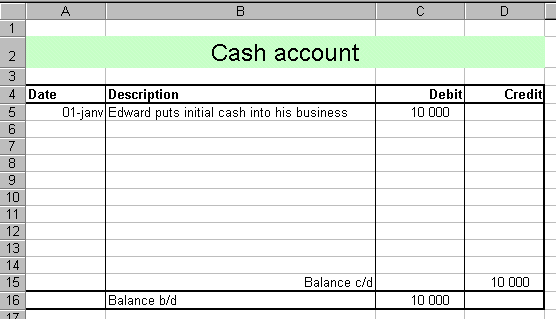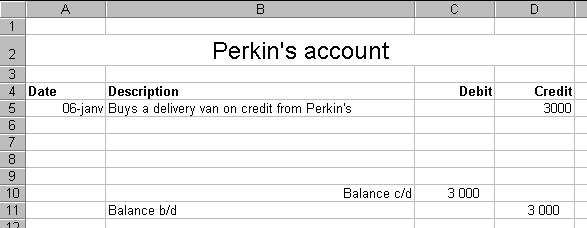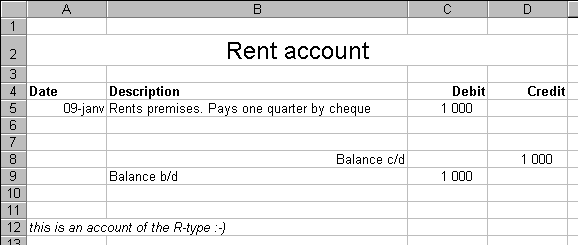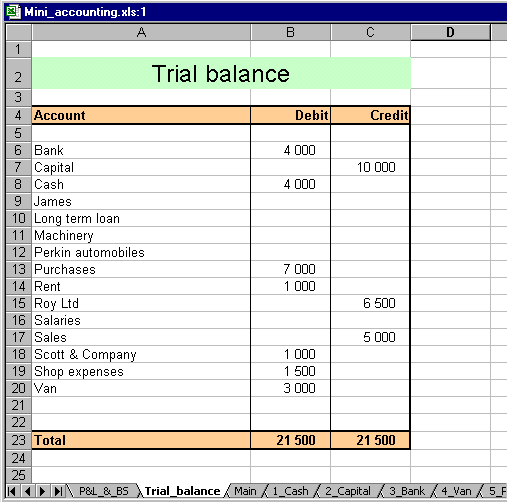
Introduction to Financial accounting 1
Session 03
Reference : the excel document used in this lesson can be downloaded by right-clicking on this link : mini_accounting.xls
A journalizing and posting process carried out and commented in detail :
Let's post the following journal recordings :

Edward puts initial cash into his business :
Some money enters the firm : Edward money (Edward initial capital) ; and the firm has some new liability : it gave Edward a piece of paper certifying that Edward put 10 000 € into the firm
So debit the Cash account, and credit the account recording liabilities to owners (the Capital account)
Cash account after this transaction :

Capital account after this transaction :

Edward (the manager of his own firm) takes cash from the till and takes it to the bank :
Credit the Cash account, and debit the Bank account.
If you consider - correctly - that Edward's firm's bank account is outside Edward's firm, then you may say that some value left the firm : cash left the firm ; and some value entered the firm : the bank gave the firm a deposit receipt.
More formally, we say that some asset (some cash) was exchanged for or transformed into some other asset : money at the bank, that is our money (deposited at the bank).
Buys a delivery van on credit from Perkin's garage :
Like in any transaction, something or some value leaves the firm, and something or some value enters the firm.
What enters the firm ? A van. So debit the Van account. It's a new asset of the firm.
What leaves the firm ? Cash ? No. A check (that is "an order given to the bank to pay Perkin's on Ed's account") ? No.
In that case, either an I.O.U. or some physical assets worth 3000 € left the firm.
Here it is an I.O.U. : Ed's firm gives Perkin's garage an I.O.U. for 3000 €.
Perkin's grants "credit" to Ed's. Perkin's trusts Ed's (and Ed). Perkin's believes Ed's is creditworthy.
So Perkin's becomes a creditor to Ed's.
And Ed's has a new liability : 3000 € owed to Perkin's.
So we credit Perkin's account.
The Van account (in Ed's books) looks like this :

Perkin's account (in Ed's books) looks now like this :

Rents premises. Pays one quarter by cheque : 1000 € :
What "leaves" the firm ? Well, the bank account (Ed's account at the bank) decreases by an amount of 1000 €. So credit the bank account for that.
What "enters" the firm ? Some sort of "value" : the right to occupy the premises for one quarter. It is not a new asset, since it is to be consumed up (unlike the van for instance).
(It is going to be an account of the R-type, measuring a flow, measuring a consumption here ; whereas the Van account is to be an account of the C-type : showing a still photograph of some assets at the time the photograph is shot...)
Create a Rent account, and debit it, because it "receives" something.
Bank account (now with already two entries) :

Rent account :

Buys goods on credit from Roy Limited :
So Roy is a supplier.
Since we (let's say "we" for "Edward's business"), since we are a small retailer Roy is a wholesaler.
What are the two usual parts of the exchange ?
Goods (from Roy) enter our firm : so debit the Purchases account.
What leaves the firm ? Cash ? No. A check ? No. It is a purchase on credit.
Roy is a supplier, and it is also becoming a creditor. So credit Roy's account.
The Purchases account :

Roy's account :

He paid shop expenses amouting to 1500 € by cheque :
What leaves the firm ? Ans. : a check ; as a consequense the bank account will decrease by an amount of 1500 €
What "enters" the firm ? Well, something that got consumed : the charperson cost, the electricity, etc.
It is going to be an account of the R-type : it measures a flow !
Shop expenses account :

Bank account after this new transaction :

Sells goods to Scott & Company on credit :
At last this firms does what any firm is designed for : it sells something !
To whom ? To Scott & Co.
Scott & Co therefore is a client.
Will money enter the firm ? Let's see. Something has got to enter the firm, since something (goods) left the firm.
Which accounts are involved ? Cash ? No. Bank ? No.
So what does the firm receive ? Ans. : an I.O.U. !
Why do we accept this ?
Probably because it was "Take it or leave it". And we have enough trust into Scott to chose to take it.
So we receive a piece of paper promissing us that we will be paid at some later date. Scott becomes a debtor.
Once, I visited my friend Pascal at his Advertizing Agency, and there were 250 new Swiss cuckoo clocks all over the shelves.
Pascal being a transversal guy, and in the advertizing trade to boot, I was not exceedingly surprised.
- Hey ! You started a new collection, I said
- No, he cheerlessly replied, don't insist...
A cuckoo just rang then. And then another one. And a third one.
- Oh, this one's got a nice chirp !
- Yeah, they don't even fu...ing all ring at the same time !, he said droopingly.
He had been paid a debt from a bad client with physical goods !
So let's cross fingers we won't get paid, like my friend Pascal, with 250 Swiss cuckoo clocks.
Anyway until this debt settlement Scott & Company account in our books looks like this :

And the Sales account is :

He settles Perkin's account by cheque :
Remember this liability ? We owe money to Perkin's because we received a van in exchange for an I.O.U.
Now we settle this debt we have to Perkin's.
What leaves the firm, and what enters the firm ?
A check leaves our bank account. So credit the bank for doing this.
What enters the firm ? Well a debt disappears. In some cases, our I.O.U. comes back to us from Perkin's garage. Or it becomes invalid because there was a deadline (and we correctly paid before the deadline, so... no commercial conflict).
Anyway our assets decrease : the bank balance decreases. But also our liabilities decrease : one of our debts is settled.
Receives a cheque from Scott (good news), in partial settlement of its debt to Ed's, and takes it to the bank :
Debit the bank account, since we send this cheque to our bank, and therefore the bank then owes us even more money.
Bank account (viewed in our books).
Sends a cheque to Roy Ltd for 500 €
Roy's account (can you do it ? and make the comments ?)
Purchases further goods from Roy ltd
One last entry in the journal : the recording of the cash sales for the month (it is customary although not mandatory to do it once a month at the end of the month)
Cash sales for the month amounted to 2000 €
What left the firm ? Goods sold.
There is the Sales account for this.
So credit the Sales account.
What entered the firm ?
Cash.
Well.
Cash account final look :

Remember : sorting all the journal transactions into accounts in not much different from classifying your incoming mail messages into various folders to keep a tidy mailer. But in accounting we make two account entries for each transaction, because it was realised in the late middle ages that a transaction affected two entities and it was more convenient to keep double entry accounting rather than simple entry.
Just like you can chose what folders you create (it's up to you, to your tastes, to your habits), you can to a large extent create whatever account you like.
In particular, remember, when you don't know where to put a new message... I mean, a transaction-half... create a new account.
Let's step back a moment :
Where have we got ?
We recorded all the transactions into the journal.
Then we created plenty of accounts to split each transaction into two halves, and store each half in the appropriate account.
We did all this, they say, to simplify the view we can have of the firm !!
How can this be ?
This can be... if we now prepare synthetic documents from the ledger of accounts.
A synthetic document is a well prepared summary.
The first synthetic document we shall prepare is a rather simple one (and yet it will already give such a powerful synthetic view of the firm that some bankers use it in preference to any other).
It is the trial balance.
The trial balance :
The trial balance is nothing more than the list of all the accounts balances brought down.
What is the bank balance ? Ans. : 4000 € in debit.
What is Perkin's account balance ? Ans. : zero
What is Roy balance ? Ans. : 6500 € in credit.
etc.
The whole trial balance is this :

(Note : you can see some accounts - empty accounts - that have been created in this accounting excel sheet, but that we haven't used.)
This document, the trial balance, is fairly simple to establish once you have the ledger accounts filled in, and yet it is rather astonishingly useful to see how the firm is doing.
Some preliminary remarks :
If all our double entries have been correctly carried out, the two columns, debit and credit, of the Trial balance must add up to the same figure (here 21500 € - don't try to give this number a meaning, it has none)
The converse is not true.
We can see at one glance who we owe money to, and who owe us money :
We owe money to Roy
In some sense we also "owe" money to the owners
The case of the sales account is different : it does not directly represent money owed to anyone (it is an R-type account)
Scott owes us money
We also see other assets we have rather nicely displayed :
How much money do we have at the bank ? Ans. : 4000 €
How much money do we have in the till ? Ans. : 4000 € (it's a meaningless coincidence that it is the same figure as our bank assets)
Scott paper, that we hold, is an asset. It is worth 1000 €.
Is it as interesting as holding 1000 € in cash ? Most people (including me) will tell you : no.
To begin with it is less liquid than cash or money at the bank.
Secondly, you are never enterely sure that your client will pay you (and not ship you 250...)
There remains the problem of interpreting accounts that are not pictures of assets or liabilities.
Those accounts are called Revenue accounts (I called them, above, R-type accounts) : they measure value that entered the firm and was used up (rent, shop expenses, goods that we purchased and resold - if we did not resell all goods purchased, we shall have to make some further accounting treatment that will be explained later.)
The Sales account records value that left the firm, but is not a liability : it is also an R-type account.
More on C-type accounts (Capital accounts) (sorry, the word capital has different usage in accounting), and R-type accounts in another lesson.
To finish with : plenty of exercises on journalizing and posting.